|
|
| Parashurama |
Parashuram was a hot-tempered person and the news and the condition of his mother made him extremely angry. He marched to the kingdom, killed all the army, cut down 998 arms of the king using his bow and arrows and killed him using his Axe. The warrior race (Kshatriyas), during that time was getting too out of control during that time and it is said that Parashuram killed all the men in the warrior race 21 times (as many times as his mother wept) in revenge.
But I digress, I was speaking of Parasrampur, the village. When I think about it, I remember summer, the sun, burning hot, the narrow road shaded by some Imli (tamarind), some Mango and some Mahua trees. I remember a couple of shops, some of them new while others beaten by the weather, made of wooden planks and just barely holding together. Thatch roof on the chai (tea) ki dukan (shop) is bravely fighting off the summer and a couple of people sitting there, sipping chai in earthen kulladh (vessel). Around them are marks of the paan (bettle leaf), broken kulladh. Some others are sitting with them chewing paan and making the rickety bench creak.
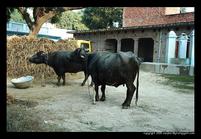 To one side of the shops passes by the nahar (canal), dry in the summers and its floor cracked by the intense heat. Alongside the
nahar runs a well-trodden path. It has been trodden by innumerable pairs of
feet, both human and the *bail gai* (oxen) beasts.
The once hard as stone ground has given way to silky smooth, fine as powder dust. Put your foot into it and it will
disapper soundlessely and effortlessely in it.
To one side of the shops passes by the nahar (canal), dry in the summers and its floor cracked by the intense heat. Alongside the
nahar runs a well-trodden path. It has been trodden by innumerable pairs of
feet, both human and the *bail gai* (oxen) beasts.
The once hard as stone ground has given way to silky smooth, fine as powder dust. Put your foot into it and it will
disapper soundlessely and effortlessely in it.
Cross the puliya (bridge) on the nahar and get to the other side, there is a pugdandi (earthen walkaway) by the side of the road. It starts big, turns narrow and enlarges again. Makunpur is right here, the mango groves that we used to play in when we were kids. Some of the trees are now dead and some dying but some still stand proud, testimony to our childhood days. The bamboo grove still stands right there where it always was. The ghost of kaluwin, still resides there I think, pass quick without looking to that side, and right where the cemented baraha (water-drain) ends, starts parasrampur.
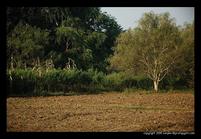 Sit at the baraha for a while and look, at some distance is my the house of my mai and baba. If you are lucky, you might
even see baba working in the fields. Mai is probably at home, doing something in the house, cooking or in general chatting
with some old crony from the village. The buffalos and the cows occupy their place in the shade in the sariya in the
afternoon while in late afternoon, they stay right in front of the house.
Sit at the baraha for a while and look, at some distance is my the house of my mai and baba. If you are lucky, you might
even see baba working in the fields. Mai is probably at home, doing something in the house, cooking or in general chatting
with some old crony from the village. The buffalos and the cows occupy their place in the shade in the sariya in the
afternoon while in late afternoon, they stay right in front of the house.
The Awanla trees, 6 of them, hide my house from the view when you look from Makunpur. These were the earliest aonwla trees planted at our house and they stand erect, proud. The aonwla from these trees is famous world across and when in the winter it fruits, the taste of it, makes the mouth water.
If you arrived in the late morning, early afternoon, the village is very quiet. Nothing moves, even the beasts stay in their sarias chewing the cud, not making any sounds. All is quiet, the village elders had their food and they are lying on their khatia, swaying the flies away. Trying to catch a nap. Inside the houses, the women of the house have just finished eating and are most probably cleaning the utensils away. The kids will be either napping of idling around.
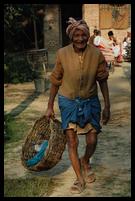 I was not really brought up in the village, but didi and Rajeev were. I am told that I was born in my nanihal and for
few years I was brought up in Dad's village. But earlier than I can remember, Dad finally brought mom to the city where he
was working as a teacher and that is where I start remembering from. Throughout my holidays from standards 1st till
standard IX, come summer holiday and mom and dad would get busy packing and then take the choo-choo to village, where the
rest of the summer holiday would be finished.
I was not really brought up in the village, but didi and Rajeev were. I am told that I was born in my nanihal and for
few years I was brought up in Dad's village. But earlier than I can remember, Dad finally brought mom to the city where he
was working as a teacher and that is where I start remembering from. Throughout my holidays from standards 1st till
standard IX, come summer holiday and mom and dad would get busy packing and then take the choo-choo to village, where the
rest of the summer holiday would be finished.
There was not really a lot of supervision once we were at village. We used to stay one month at the paternal village and for one month at my nanihal. Even though I was more familiar at dad's place, somehow it was better at mom's place. Probably because there she got all freedom and was busy playing the role of a daughter rather than the mom she had to all the time. Irrespective of the place, one thing remained constant. The mangoes at the villages were usually plenty. Then there was the golahinda. Golahinda, the legendary, mighty tree stood erect and proud, taller than any other tree for all my childhood and most of my teens. It is now gone. One day the vultures came and built their nest in the tree and that was the day the health of the tree drained away. Try how hard they might, the villagers could not make the vultures abandon their nest and eventually, the demise of the tree was what made them move. The fruit in the tree were plenty, sweet and very ripe. It was not possible to climb the tree for it was extremely tall and there weren't any branches for at least 20 ft, but waiting underneath it for a ripe mango to fall was a lot of fun.
Next to Golahinda was a small grove of mango, jamun, kathal (jackfruit) and Mahua trees. These trees were of moderate height and we could climb on them and play Chilahro. As kids we spent quite some time in this grove.
Next to Golahinda and Vidya's Grove was our tubewell pump. When Grandad had the tubewell setup, he got a big huge cement tub made right in front. When the tubewell would start, first the tub would fill up and then we would jump in. It was a lot of fun jumping in the tub and feel the cold water around your body in the summers.
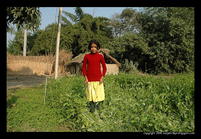
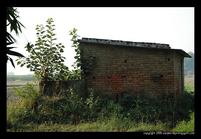 Our fields were right in front of the tubewell. Across the fields and across the
earthen path, was the house of Benchu. Benchu had a gadahi (small pond) near his
house and I never saw any water in it except for the one time I visited village
in rainy season. Benchu had a peculiar tree planted by his house. The tree was
called "Dhera" (Alangium lamarckii, Sage-leaved alangium) and I have not seen the fruit or the tree anywhere else. The
fruit was tasty and as a kid I plucked and ate it a few times. Mom always used
to snap at us for eating fruits from those trees because according to her,
Benchu used to dry animal hide on that tree (we are vegetarian).
Our fields were right in front of the tubewell. Across the fields and across the
earthen path, was the house of Benchu. Benchu had a gadahi (small pond) near his
house and I never saw any water in it except for the one time I visited village
in rainy season. Benchu had a peculiar tree planted by his house. The tree was
called "Dhera" (Alangium lamarckii, Sage-leaved alangium) and I have not seen the fruit or the tree anywhere else. The
fruit was tasty and as a kid I plucked and ate it a few times. Mom always used
to snap at us for eating fruits from those trees because according to her,
Benchu used to dry animal hide on that tree (we are vegetarian).
Chilbil (holoptelia integrifolia, also known as rajain) Kaitha (Feronia Elephentum, Wood/Elephant Apple) Jamun (eugenia jambolana or Syzygium cumini L)